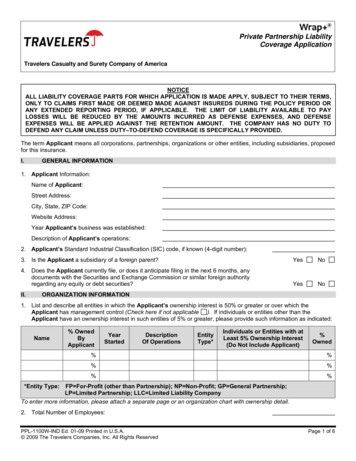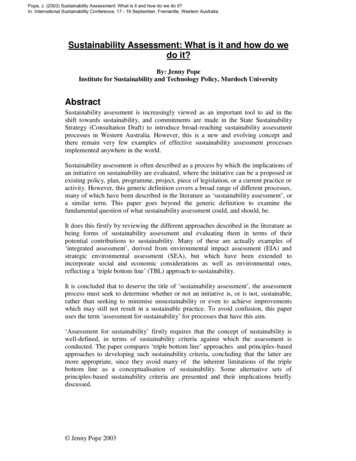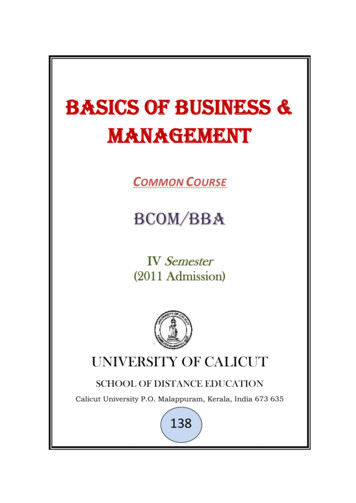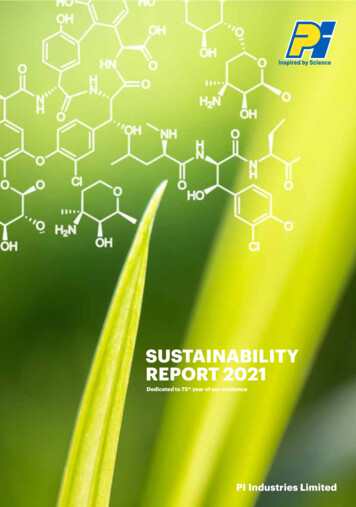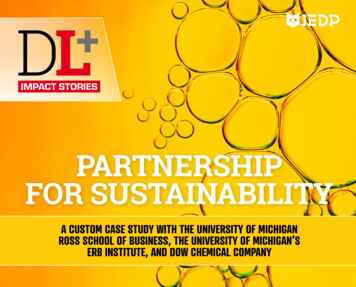
Transcription
DLIMPACT STORIESPARTNERSHIPFOR SUSTAINABILITYA CUSTOM CASE STUDY WITH THE UNIVERSITY OF MICHIGANROSS SCHOOL OF BUSINESS, THE UNIVERSITY OF MICHIGAN’SERB INSTITUTE, AND DOW CHEMICAL COMPANY
DL The University of Michigan Ross School of Business, The University of Michigan’s Erb Institute, and Dow Chemical CompanyThe Dow Sustainability Academy, launched in 2017through a partnership between Dow, the Universityof Michigan Ross School of Business and theUniversity of Michigan’s Erb Institute, empowersDow employees from all levels and all functions tocontribute to the company’s sustainability efforts.As a Credit Analyst in the Customer FinancialThe Dow Sustainability Academy, a program developed in 2017Louiseefforts, was created and implemented as a collaborationServices group at Dow Chemical Company,Weidemanfelt“disconnectedfrom sustainability and Dow’s efforts ofsustainability.” So when she saw an opportunity to apply forthe Dow Sustainability Academy she jumped at the chance.“What inspired me to apply to be a part of the program reallycame back to one of the reasons I was interested in workingfor Dow in the first place,” Weideman said. “When I wascompleting my bachelor’s degree, we had the Director ofSustainability at Dow come and talk to the business collegeto involve more employees in the company’s sustainabilitybetween Dow, the University of Michigan Ross School ofBusiness, Michigan Ross Executive Education, and the Universityof Michigan’s Erb Institute. The clear alignment between theUniversity of Michigan’s ideas and priorities on sustainabilityand those of Dow Chemical is reflected in the mission of the ErbInstitute “to create a socially and environmentally sustainableworld through the power of business.”about how important sustainability is in the business worldThe Sustainability Academy enrolled about 40 participants severalthat Dow is putting towards sustainability that he sharedprogram for Dow employees at the University of Michigan’s Anntoday, especially in manufacturing companies. The effortswith us, and the different videos he showed us about theimpact Dow was making, was really inspirational to me.”2times a year, and consisted of an intensive three-day academicArbor campus, followed by a five-month real-world sustainabilityproject developed by teams of Academy participants.“When I was completingmy bachelor’s degree,we had the Director ofSustainability at Dowcome and talk to thebusiness college .The efforts that Dowis putting towardssustainability that heshared with us, andthe different videoshe showed us aboutthe impact Dow wasmaking, was reallyinspirational to me.”
The University of Michigan Ross School of Business, The University of Michigan’s Erb Institute, and Dow Chemical Company DL “Our new aspiration is tobe the most innovative,customer-centric,inclusive, sustainablematerial sciencecompany in the world.”A Conversation Between PartnersMichigan Ross and the Erb Institute have partnered withDow for many years, including developing case studieson Dow with Dow’s participation, creating a series ofvideos with the company to coincide with Earth Day, andsending students to Dow as interns.According to Michigan Ross School of Businessprofessor Joe Árvai, director of the Erb Institute andthe faculty director of the Sustainability Academy,the Dow Sustainability Academy came about through“We do have a lot happening at the leader level,”agreed Dena Pflieger, Dow Sustainability ProgramManager. “But our new aspiration is to be the mostinnovative, customer-centric, inclusive, sustainablematerial science company in the world.” Achievingsuch ambitions could not only come from top-downpushing activities. “We need everyone to think aboutwhat it is we’re trying to do with sustainability, and howthey can actually make a difference, and implementthose goals.”discussions about developing a case around DowOnce the need to connect more employees withsuch as “Safe Materials for a Sustainable Planet,”Árvai worked with Dow’s sustainability leadership atrelated to their 2025 Sustainability Goals. With goals“Valuing Nature,” and “Advancing a Circular Economy,”the 2025 Sustainability Goals were a set of 12 goals thatframe the current focus areas of Dow’s sustainabilityefforts. The 2025 goals represent the third decennialiteration of Dow sustainability goals, following previousgoals set for 2005 and 2015.“Out of that conversation about the case,” noted Árvai,“we started to talk a little bit about the importance oftrying to embed the ethos of the 2025 Goals acrossthe entirety of the company. There was a sustainabilityoffice and there were managers with responsibility forsustainability, but my understanding was that therewas no across-the-company commitment to trainingall employees within Dow about the importanceof sustainability.”the company’s sustainability efforts was recognized,the time in “sketching out what might be interestingand important for the participants to learn. And outof a series of maybe a half a dozen conversations,we developed a template for the very first DowAcademy.”The choice of participants in the Academy reflectedDow’s ambition to involve people at all levels insustainability. As Pflieger explained, participants wereat “the functional specialist type of level. Most ofthem were not managers, but at the level right belowthat. So we were looking at folks who would possiblybe the future leaders. And because they were thepeople doing the day-to-day work, who understandhow things work, this gave us another chance toimpact the organization at a different level.”5
DL The University of Michigan Ross School of Business, The University of Michigan’s Erb Institute, and Dow Chemical CompanyThree Days at MichiganTools for SustainabilityThe first step for participants was the intensive three-The purpose of the on-site portion of the programthe University of Michigan Ross School of Business.comprehensive understanding of sustainability, but alsoday academic program at the Ann Arbor campus ofThe three days began with an introduction to the roleof policy-makers and policy in increasing sustainabilityin the world. As Árvai explained, “We started withan introduction to the policy world culminating in awas not only to help the participants develop a morethe why, the faculty at Michigan now focused on the how.project work. Participants were given a list of 10 to 12sustainability initiatives. In other words, having coveredsociety. It explained where policy falls short. And thenpractitioners implement sustainability practices andcase for sustainability.”One of the three days’ key lessons at Michigan Rosswas understanding the different facets of sustainability.behaviors. “We had 16 of them that covered differentrecollected Weideman. “That way I could learn moredimensions of actually doing business sustainability, fromstakeholder analysis and materiality to the triple-bottomline, horizon issues and the business case,” said Árvai.business success,” emphasized Árvai. “What we taughtand things that applied to everybody’s projects,” recalledthrough the lens of social, environmental and economicdimensions.” The social component of sustainabilitycovers everything from labor, human rights, and thethat could help us along with our brainstorming processparticipant Weideman. Despite the wide variety ofprojects, “the professors were able to give us informationand tools that were relevant to everyone.”impact on communities to equality, working conditions,For Weideman, one of the most powerful tools she broughtour definition of sustainability that it’s enough to thinkanalysis map, which consisted of a four-quadrant graphforced labor, and other issues. “We don’t believe inabout environmental protection and economic benefit,”Árvai noted, “if at the same time you’re leaving a legacyof waste or toxicity that would negatively impactcommunities long-term.”6projects and asked to list their top three choices.“I decided to go out of my comfort zone and put my“They provided us with some very specific tools to usethem right away was that we look at sustainabilityThe next phase of the Sustainability Academy was theextensive set of Erb Institute “tool-boxes” to help“For many participants sustainability was very muchthe blend of environmental protection and a kind ofsuccessful,” she said.Outside the Comfort ZoneAt this time, the participants were introduced to anwe moved into a lengthy discussion of the businesswere going to need to work with to get your project to beto give them tools that they could apply to implementdiscussion of why policy on its own isn’t going to beenough for the advancement of sustainability in ourproject, you realize the key people or groups that youhome from the courses at Michigan was a stakeholderin which circles represented stakeholders. The size of thecircles reflected the stakeholder’s size and importance,as well as the impact the project in question would haveon them. “After you put in all your stakeholders for yourinterest in projects that weren’t really related to my role,”about different areas of Dow, and perhaps get assignedto a team with people outside of finance as well. Iended up getting my number one choice, which was aproject aligned to Dow’s goal for engaging for impact.That’s one of our sustainability goals for 2025: to getlots of Dow people and the Dow community involvedin volunteerism and achieving our sustainability goals.”Dow developed the pool of projects offered toparticipants. The Sustainability Academy asked thecompany’s sustainability goal leaders and leadersfrom all of its businesses to submit a project. “Theyalso had to charter the project,” Pflieger remarked. “Weused Sustainability Academy alumni to help work withthe client to refine the charter.” The Academy has alsorefined its criteria for projects over time to make themnot only better projects for the groups, but offering morevaluable better outcomes for Dow.“We don’t believein our definitionof sustainabilitythat it’s enoughto think aboutenvironmentalprotection andeconomic benefit,if at the same timeyou’re leaving alegacy of wasteor toxicity thatwould negativelyimpact communitieslong-term.”
The University of Michigan Ross School of Business, The University of Michigan’s Erb Institute, and Dow Chemical Company DL “I decided to go out ofmy comfort zone andput my interest inprojects that weren’treally related to myrole. That way I couldlearn more aboutdifferent areas ofDow, and perhaps getassigned to a teamwith people outsideof finance as well.”Pflieger acknowledged that the charters could still beit helped them both learn the process of testing and thetransform the charters into more specific projects.and see what is good and bad in our community, andambiguous, at which point the Academy participants wouldSuch was the case with Weideman’s project. “Our projectscientific way that you can learn about the environmentgot them interested in STEM careers.”charter was very vague when we started,” she remembered.The second part of the project was a cultural surveytasked with brainstorming ideas on how to get peopleWith the help of the HR department (Weideman notedWeideman and her three Academy teammates weremotivated and inspired by sustainability and the company’ssustainability efforts.Over the first two months of the project, the fourparticipants generated a long list of 50 potential projects toget people involved. With just four months left to completethe assignment, the team chose two projects to focus on.The first one was a sustainability project challenge, whichinvolved setting up an online site where people could entertheir ideas for large-scale volunteerism projects in thecommunity. The team then recruited a panel of differentleaders across Dow to read over the submissions anddecide which one would make the biggest impact andintended to help understand the barriers to volunteerism.that her stakeholder analysis pinpointed who couldhelp them the most with this project), the team sentout surveys to 500 employees with questions such as:“Why are you passionate about volunteering? What’sstopping you? Do you have leadership support? Doyou have time during work or outside of work?” Basedon an analysis of the survey results, “We were ableto put together a really nice presentation for our HRand corporate citizenship leaders to show them whatwas preventing people from volunteering and how toovercome these barriers and encourage volunteerism,”Weideman recalled.get the most number of people involved. The team alsoExpanding in New Directionsto the winner of the challenge.sustainability training, said Pflieger. Given its success,convinced the Dow Foundation to provide a 10,000 grant“There were wonderful, great ideas in there and I hopethe other entrants were able to move forward with theirs,”Weideman said. “But we picked a project that a teamsubmitted about water quality and getting elementaryschool children involved in testing water in the area. And soThe Dow Sustainability Academy is Dow’s flagshipthe company was inspired to expand the Academyconcept to other parts of the world. In 2019, Dowlaunched Academies in EMEAI (Europe, Middle East,Africa, India), Latin America, and the Asian Pacific region— all based on the model developed with the Universityof Michigan in the United States. The Asian Pacific9
DL The University of Michigan Ross School of Business, The University of Michigan’s Erb Institute, and Dow Chemical Companymodel was slightly different since customers, as well asemployees, were participating.The flagship Dow Sustainability Academy also providedlessons and experience that prompted the Erb Instituteand the Ross School of Business to plan for two newsustainability executive education programs. Unlike customprograms tailored for large companies, such as Dow, theRoss and the Erb Institute envision that these programsAs for Weideman, although her project is finished, shecontinues to be involved with the Dow SustainabilityAcademy by coaching future Academy project teams“just to keep them on track, give them some guidance onresources, show where they can find more information,”she said. “I want to encourage them to go outside theircomfort zone and use every connection they can to makethe best deliverable of their project.”would be accessible to anyone.Weideman believes the Dow Sustainability Academy will“Imagine that you have just been given the reigns to theand functions and experience at Dow to learn moresustainability agenda of a company, whether it’s a startup oran established firm, whether it’s small or large,” suggestedÁrvai. “And you need to bring yourself up to speed on thekinds of issues that you’re going to be confronted withwhen you’re holding the reins of that portfolio.” Our planned“Sustainability 101” course is designed for that kind ofemerging leader, he said.A planned Sustainability 201” program would follow forthose who might have been in a sustainability leadershiprole for a few years and are looking for advanced tools andtechniques for business and sustainability.For more info the Erb Institute, visit erb.umich.edu.continue to inspire Dow employees of all different agesabout sustainability in general and Dow’s sustainabilityefforts in particular. “It’s awesome that Michigan Rossis willing to share their expertise with us,” she declared.“Michigan Ross is one of the best-known schools inour state. Dow is one of the best-known companies inour state and it’s just really great to see them workingtogether to educate our employees and inspire themto continue to align themselves to Dow’s goals. Andit’s a wonderful experience for people to get back intoan educational setting and really take the time to learnabout the importance of sustainability and how we’reable to contribute.”For more information on the Dow Sustainability Goals 2025, visit /2025-goals10“Michigan Ross is one of the best known schoolsin our state. Dow is one of the best-knowncompanies in our state and it’s just reallygreat to see them working together toeducate our employees and inspire them tocontinue to align themselves to Dow goals.”
About The University of MichiganRoss School of BusinessThe Michigan Ross School of Business is a vibrant and distinctive learningcommunity grounded in the principle that business can be an extraordinary vehiclefor positive change in today’s dynamic global economy. Michigan Ross’ mission is todevelop leaders who make a positive difference in the world. Through thought andaction, members of the Ross community drive change and innovation that improvesbusiness and society. Michigan Ross Executive Education, a Financial Times Top 10Global Executive Education Provider, delivers this mission to business professionalsand corporate clients around the world.Developing Leaders looks at the critical confluence between the provision ofexecutive education and the real everyday needs of organizations to strengthentheir management teams, their corporate performance, and their leadership.DL are case studies with a difference. Combining technical methodology with a newsroomsensibility for storytelling. Getting to the heart of the best custom executive programs in the world.Published by IEDP www.iedp.com
between Dow, the University of Michigan Ross School of Business, Michigan Ross Executive Education, and the University of Michigan's Erb Institute. The clear alignment between the University of Michigan's ideas and priorities on sustainability and those of Dow Chemical is reflected in the mission of the Erb

